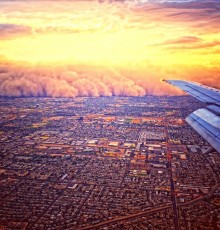What's in a Name?
 www.phoenixnewtimes.com - Laurie Notaro's Five Reasons Why Haboobs Are Awesome
A recent caller on a talk radio station in Phoenix (I’m paraphrasing):
www.phoenixnewtimes.com - Laurie Notaro's Five Reasons Why Haboobs Are Awesome
A recent caller on a talk radio station in Phoenix (I’m paraphrasing):
“Why do we call them haboobs? They just used to be dust storms. In the Northeast, they have storms that cause whiteouts. They call those storms Nor’easters. We should call our dust storms Sou’westers. When did our storms become monsoons? We just used to have a rainy season. There’s only one monsoon, and it’s in India.”
There’s much to unpack here, and it’s all about geography! First, let’s take a look at the use of the term ‘haboob’. This term blew up in the media after the huge June 5, 2011 event. We even made the New York Times. History: this term has been used describe dust storms in general since at least the 1800s. In Arizona, the term went mainstream with the 1972 article, An American Monsoon.
A haboob is a dust storm generated by the down drafts of a thunderstorm. Cold down drafts are more dense and move out ahead of the storm (outflow). If the outflow picks up dust, it becomes a haboob, a very specific type of dust storm. by Matthew McIver, http://prints.matthewmciver.photo
by Matthew McIver, http://prints.matthewmciver.photo
A Nor’easter is another specific type of storm, where the winds are blowing predominantly from the northeast (winds are named for the direction that they are coming from). Along the East Coast, a northeast wind means that the wind is coming from the ocean, bringing lots of moisture. When that moisture hits a cold air mass, it condenses, making some of the most extreme snowstorms on record. In fact, most extreme winter storms like Nor’easters are actually types of mid-latitude cyclones.
So, with that logic, we can’t call our dust storms Sou’westers because that would mean that our dust storms would be coming from the southwest. Since our dust storms/haboobs are generated from storm outflow, they can come from any direction. A lot do come from storms over Tucson, but we get just as many from storms generated over Globe (east), Cave Creek (north), and Wickenburg (northwest).
Finally, a monsoon is a seasonal reversal of the winds (the word ‘monsoon’ means season). A monsoon is NOT a thunderstorm! The most well-known and researched monsoon is the Indian Monsoon, where winds “reverse” to a more southerly (and moisture-laden) flow. There are monsoonal flows on every continent (except Antarctica).
It’s possible that we could tap into a lot of tropical moisture this week (from Hurricane Linda in the Pacific), which could generate more storms. We’re not done with the monsoon yet!

